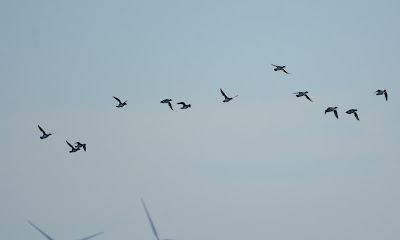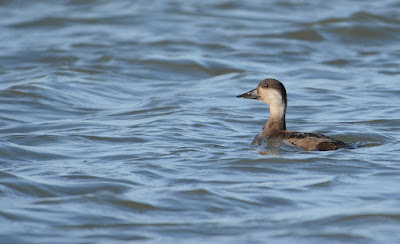A VERY MERRY CHRISTMAS TO ALL,HOPE EVERYONE HAS A GREAT DAY.
Click on photos to enlarge, please do not copy photos without permission
Sunday 24 December 2017
Saturday 23 December 2017
Blackwater Boat Trip
December 16th
This has been in mind for a few years with Steve at Swallow Birding, always seemed too busy but finally got round to it this year.
Essex birding at its best with many of the winter hard to see species all on view on the trip, we launched from West Mersea on a very cold but sunny day.
The trip took us right up the Blackwater and we were out around 4 hours, good to see past regular haunts like Old Hall Marshes and Rolls Farm from a different perspective.
With a rising tide many wader species were gathering for pre roost, large flocks of Knot and Dunlin were very evident along with seemingly endless Wigeon and Dark Bellied Brent flocks, a fantastic sight.
Being on a boat birds do not seem to spook as much allowing really good views, many highlights, Steve pulling out a Glossy Ibis was probably bird of the day but there was so many other ‘goodies’.
My sightings were as follows –
Red Breasted Merganser – probably around 40 – constant flocks
Goldeneye – around 30, one good largish flock seen
Great Northern Diver – 5 seen, one species I wanted to see, spectacular to see 5
Marsh Harrier – 4 probably more
Shag – 3 seen including one in the harbour and one that came up alongside the boat
Glossy Ibis – seen in flight before landing
Common Scoter – around 20 including a couple of close females
Common Buzzard – 2 seen
Greater Scaup – female type seen
Red Kite – one crossing from Bradwell
Slavonian Grebe – one seen very well
Black Necked Grebe – 2 again seen well
Guillemot – one seen, a right poser.
A thoroughly enjoyable trip which I will definitely be going on again, thanks to Steve and the team and good to meet Rob Sheldon, hopefully I can get on the next one.
Wednesday 13 December 2017
Inner Thames Wader survey
This is the 6th year running that this has taken place, again very kindly led by the Environment Agency who again provided the time and boat to monitor high tide wader roosts within the Inner Thames.
The areas covered, as in previous years, were from Broadness Point, Swanscombe then upriver to Beckton, Galleons Reach.
A four man crew consisted of Peter, Dan, Kat and myself.
This will go down as the coldest one yet, I am pretty conditioned to cold weather having worked outside most of my life, having a good layer of blubber around my waistline helped but I was still bloody freezing.
Travelling along the Thames at 25 knots in sub zero temperatures, sitting in the same position for 4 hours is not ideal, after an hour my feet and hands had disappeared and were completely dead despite multiple layers of clothing.
However the birding as always provided great highlights and kept us all ticking over as we checked the various roosts and collected the data along with a number of photos.
 |
| Dunlin |
 |
| Golden Plover |
 |
| Johnson's Wharf Roost |
 |
| Fords Dagenham Roost |
 |
| Grey Plover |
 |
| Johnson's Wharf Roost |
 |
| Johnson's Wharf Roost |
 |
| New Roost |
 |
| Stone Barges - Turnstone |
 |
| Stone Ness Point |
 |
| Single Avocet at West Thurrock, couldn't get closer water to shallow |
The photos help a lot, I can do estimated counts of the various roosts but for accuracy the best way by far is to count the various species later on a photo. Additionally it also turns up species that may be missed first time round, this was illustrated when I found Avocet and Ringed Plover from distant photos.
Results below for this year and comparison data underneath from 2016.
Totals
2017
2016
Curlew
21
16
Redshank
515
554
Lapwing
434
388
Dunlin
1719
1644
Oystercatcher
0
0
Grey Plover
3
3
Black Tailed Godwit
324
252
Turnstone
1
1
Ruff
0
0
Ringed Plover
2
2
Avocet
1
0
Common Sandpiper
2
0
Bar Tailed Godwit
0
1
All looks pretty similar to 2016; Black Tailed Godwit numbers are ok again but Redshank show a slight decline again. However looking back further, it could just be our recent milder winters are not pushing birds up the Thames like it used to when winters were harder.
A new roost was also located between Fords and Ferry Lane.
 |
| This Harbour Seal followed us for a short while. |
A big thanks again to the Environment Agency.
| |
Saturday 9 December 2017
Cooling Marshes of late
Another winter is here and another chance to visit a site that I have been lucky enough to survey now for 5 years.
Seeing it change from fields/ditches to a new breach over the course of time has been a privilege, different habitats but both providing great areas for birds.
Last Sunday (3rd) at high tide was probably the largest high tide count I have had there with a massive 453 Shelduck, 214 Grey Plover, 3300 Dunlin and 181 Avocet.
Impressive totals and by far the largest counts so far.
 |
| Black Tailed Godwit and Knot roost |
 |
| One of the resident Kestrels hunting near by |
 |
| Distant shot of a Merlin after a Linnet |
 |
| Dunlin and Grey Plover |
Raptors are being seen regularly, the hoped for Hen Harrier as yet have failed to materialize, the numbers of old are gone, the impact of consistent persecution up north on Grouse Moors has sadly reduced them drastically.
I can still remember seeing up to 8 birds wintering on Rainham Marshes many years ago on the Silt Lagoons, hopefully those days will come back.
Marsh Harriers however are faring well as are Merlin, on Sunday I saw both male and female both hunting over the fields.
Sunday 19 November 2017
Battersea Power Station 2017
Another good year for the pair, as per 2016 they have again fledged 4 juveniles with construction works in full swing.
The 4 chimneys have now all been demolished and rebuilt, now painted, the peregrines are again using them extensively for hunting along with many of the site Cranes. The fact is that they simply never stopped using the chimneys even during re construction, having spoken to some of the chimney workers; many have had incredible views aloft of the birds.
Once the new glass lift to the top of the North West chimney is in situ, I would imagine the public will not only get incredible views of London, but also of the peregrines ghosting by.
 |
| Adults on new chimneys |
 |
| Juvenile and adult Tiercel |
 |
| The family |
We unfortunately lost one of the juveniles, much the same as in 2016, this is sad but normal and has happened on at least 5 of the sites that I monitor this year, fledging in an urban area can be a hazardous business I’m afraid.
Of the 3 siblings, the 2 females had left by September/October and to date, the remaining juvenile male is still present, like last year it looks like we have another long stayer.
 |
| Cranes being used extensively as launch posts for hunting |
Since 2013, the pair with the new female who arrived Christmas 2012/2013 have produced 17 juveniles, an excellent breeding ratio averaging 3 per year.
With works now starting on the Power Station itself, it will be a challenging time for them but I suspect like previous years they will adapt.
 |
| Juvenile |
In 2+ years time the plan is to relocate them back onto the Power Station, a permanent nest site has been designed especially for them, hopefully to their liking – fingers crossed.
Subscribe to:
Posts (Atom)






























